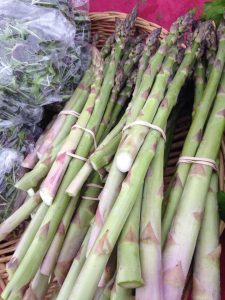
We were picking up a couple of bunches of asparagus at the local farmers’ market when we overheard a customer ask the farmer, “Why are these asparagus so many different sizes and why are they so long?” His question was a spontaneous reaction to seeing asparagus unlike the supermarket variety, with their uniform-sized spears packaged up into tidy bundles, that he was more accustomed to. The farmer explained that the asparagus grow this way, that the stems don’t thicken with age but are already thick or thin when they poke out of the ground. When they’re harvested together, they create a mixed bunch. As for length, rather than forcing the asparagus into same-sized spears and tossing out what may be usable, most farmers leave them untrimmed to prevent waste. So the next time you see an unruly bunch of asparagus, you’ll know you’re getting as much from each spear as possible. And, contrary to popular belief, thin spears aren’t necessarily more tender than thick, and, instead, is related to maturity and freshness.
Season: From now through June, depending on weather. To find locally grown asparagus, visit Seacoast Harvest.
Storage Tips: For best flavor, eat soon after harvesting. To keep asparagus, treat them much as you would cut flowers — stored upright, cut-ends down in a container with one to two inches of water, either at room temperature or in the fridge for up to a week.
Preparation: Asparagus can be eaten raw, steamed, boiled, sautéed/stir-fried, grilled, or roasted. For more cooking ideas and recipes, visit our collection on Pinterest.
Feeling curious? Send your local-food questions to debra @ seacoasteatlocal.com. Debra writes about eating locally at her blog, Diary of a Tomato. Photo courtesy of Seacoast Eat Local.
